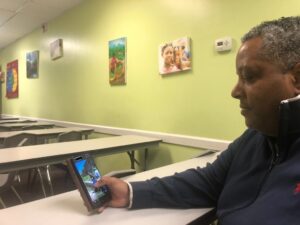
Kimberly Carchipulla, center, and her 5-year-old son, Damien Salinas, right, walk in New York City in September. Carchipulla and her family emigrated from Ecuador in June and have been living in a room at the historic Roosevelt Hotel, converted into a city-run shelter for newly arrived migrant families hoping to find work, a new home and a better life (Andres Kudacki/The Associated Press).
NEW YORK CITY — States and cities are taking advantage of expedited work authorizations for a flood of new migrants, seeking to match them with jobs so they can support their families while they wait for asylum hearings.
Allowing migrants to work might enable many of them to leave shelters in cities that were already strained by local homeless populations but have been further overwhelmed by the newcomers.
New York Democratic Gov. Kathy Hochul said this week that the state Labor Department had identified 18,000 potential jobs for migrants around the state. Hochul had already called on National Guard troops to help with work authorization paperwork.
“Migrants and asylum seekers came here to work — so let’s put them to work,” Hochul said in a statement. “Right now, we have a migrant crisis and a workforce crisis … we can solve them both.”
New York and other states got a big win when the Biden administration announced last month that it would give temporary legal status, which includes permission to work, to Venezuelan migrants who arrived before August. The administration also pledged faster action on work permits for other migrants seeking asylum. About 44,000 of the 107,000 migrants who entered New York City between spring 2022 and August 2023 are from Venezuela.
Also this week, New Jersey said it would spend $2.5 million to connect migrant workers with employers through a new website. Illinois Democratic Gov. JB Pritzker said that he was “thrilled” by the Biden administration’s promises of new work authorization for Venezuelans, who make up the largest share of Chicago’s new arrivals. But Pritzker urged the federal government to speed up authorizations and waive fees “for those who cannot afford them and just want to be able to work and build a better life.”
The question of how to handle an influx of migrants is a quandary in states and cities around the country. A labor shortage has employers scrambling to find workers, while city shelters are overflowing with newcomers who can’t work legally to support themselves.
“People are seeking freedom and protection, but we also have a big ‘Help Wanted’ sign out there. There’s a push and a pull [bringing immigrants here],” said Abel Nuñez, director of the nonprofit CARECEN, which works with new migrants in Washington, D.C.
Among those seeking work is Edgardo Marín, a 34-year-old forklift operator who fled Venezuela with his wife and small children and now lives in a Manhattan shelter in New York City. Marín, who was getting asylum advice at a Methodist church in the city on a recent day, said he had to leave his home country because he had been identified as a dissident by a “colectivo,” a far-left paramilitary group aligned with the government.
“We had to flee Venezuela because I am against the government,” Marín said, speaking in Spanish. “I always hated it. It produces nothing but poverty and steals everything for itself. I was part of a group marching against the colectivo, trying to put pressure on them. They came after me and tried to kill me and my family — my mother and my brother-in-law were imprisoned because of all this.”
The colectivos are part of a pattern of violence in Venezuela that blurs the line between politics and crime, said Héctor Arguinzones, a Venezuelan native who fled in 2015 and now works with new migrants in New York City.
“There’s a very fine line between political oppression and gang crime in Venezuela, and that’s a big reason why Venezuelans are fleeing,” Arguinzones said. “Sometimes the gangs get control of the government and use it to threaten people. Sometimes the government uses the gangs to control the population.”
Gang violence is a valid asylum claim, but federal law is complicated. About 29% of asylum cases from Venezuela were granted in fiscal 2023, according to the latest federal statistics.
State help
California, Colorado and Minnesota have been most active in helping immigrants without regard to legal status, said Eric Figueroa, a senior manager at the Center on Budget and Policy Priorities in Washington, D.C. States have shown they can give access to health insurance, driver’s licenses and resident college tuition discounts, he said.
A Minnesota law allowing driver’s licenses went into effect Oct. 1. Illinois has many of the same benefits for migrants, regardless of immigration status, but had to cut back on health care benefits in a recent budget crunch.
“What people really need is federal legislation to normalize their status, but if that’s not going to happen, the states can do something to step in and ease their way a little bit,” Figueroa said. “You can help millions of people live better with something like driver’s licenses, a mundane thing for you and me, but it’s a huge deal for unauthorized people.”
In New York, a 31-year-old woman who asked to be identified only as Judy said she and her family are eager to work when they get permission. She can cook and clean houses to get started, she said.
Judy said she fled Colombia because her business as a street food vendor was ruined by escalating gang demands for protection payments gang members called a “vacuna,” or vaccination.
“They wanted money and food for all of them, and they threatened to beat us when we couldn’t pay,” Judy said. She, her husband, a baby daughter and 6-year-old son made a perilous journey with friends on foot to the United States, using the last of their money in Piedras Negras, Mexico, on bus fare to the U.S. border. Drug dealers on the bus stole the last of their possessions, she said.
“We got here with nothing,” said Judy, who lives in a New York City shelter.
Marín said his family also made the arduous journey on foot through the jungles of Panama, seeing bodies of migrants by the path and finding a Venezuelan flag left at a resting spot.
“It was horrible. Four days in the jungle,” Marín recounted. He said he would like to make money and get out of a city shelter but hasn’t been able to find work. “They ask me for papers and a Social Security card, and I don’t have them,” he said.
A surge of immigrant arrivals
About 2.2 million migrants crossed the United States’ southern border from October 2022 through this past August, up about 3% from the same period the previous year and up more than fivefold from 2020. Recent asylum-seekers are concentrated in New York City, Miami, Los Angeles, Houston and Chicago, according to an analysis by TRAC at Syracuse University based on immigration court filings from March 2021 to May 2023.
At least a dozen Republican states have sent National Guard troops to the Texas-Mexico border to attempt to deter illegal border crossings. They include Arkansas, Florida, Iowa, Mississippi, Nebraska, North Dakota, Oklahoma, South Carolina, South Dakota, Tennessee, Virginia and West Virginia. Ohio sent state highway patrol officers to the border in Texas.
Last year, Republican Govs. Greg Abbott of Texas and Ron DeSantis of Florida — a presidential candidate — made headlines by busing newly arrived migrants to Democratic-controlled cities and states such as Washington, D.C., California and New York. This year, Arizona Democratic Gov. Katie Hobbs also put migrants on buses, saying she wanted to help get them closer to their final destinations.
The resulting tide of families has overwhelmed many cities. Nuñez, the CARECEN director, said earlier waves of migrants only used Washington as a transfer point to reach family and friends elsewhere.
“We then also began to deal with the fact that 10% to 20% also wanted to make D.C. their home, to integrate into our city,” said Nuñez, speaking at a September conference on immigration policy.
“When you’re the actual final destination, it creates a whole host of other issues,” he said. He recalled how migrants arriving at a D.C.-area bus station found themselves walking through a tent encampment in search of help.
“Our inability to house people, period, was a challenge. Most of them have been on this arduous journey. It breaks your heart to hear some of their stories. They think once they made it over the border, they’re on easy street. And we have to tell them, ‘No, the journey continues.’”
Stateline is part of States Newsroom, a nonprofit news network supported by grants and a coalition of donors as a 501c(3) public charity. Stateline maintains editorial independence. Contact Editor Scott S. Greenberger for questions: [email protected]. Follow Stateline on Facebook and Twitter.
Our stories may be republished online or in print under Creative Commons license CC BY-NC-ND 4.0. We ask that you edit only for style or to shorten, provide proper attribution and link to our website. AP and Getty images may not be republished. Please see our republishing guidelines for use of any other photos and graphics.




